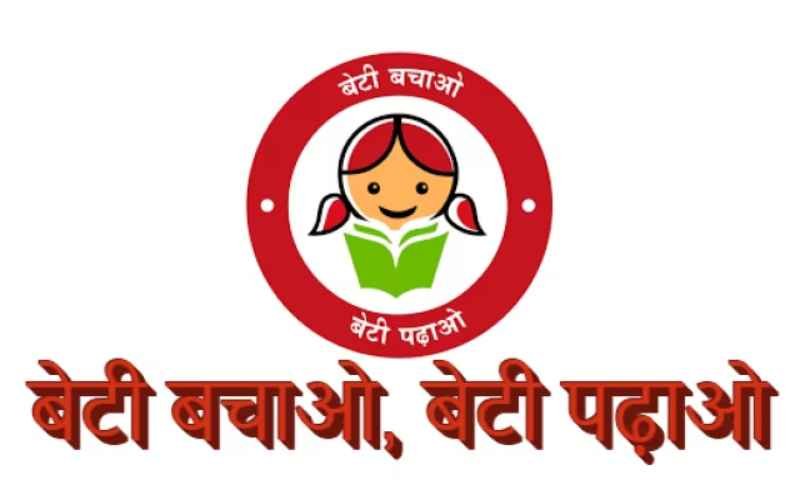In 2015, the Indian government introduced the Beti Bachao, Beti Padhao (BBBP) scheme to address concerns about gender discrimination and women empowerment in the country. The name Beti Bachao, Beti Padhao translates to ‘Save the girl child, educate the girl child’. The scheme aims to educate citizens against gender bias and improve the efficacy of welfare services for girls. With initial funding of Rs. 100 crore (US$ 13.5 million), it embarked on a journey to revolutionize societal perceptions and practices.

Objectives:
The BBBP Yojana, or the Beti Bachao Beti Padhao (Save Daughters, Educate Daughters) Scheme, encompasses a range of objectives aimed at addressing gender disparities and fostering the well-being and empowerment of girls in India. Let’s delve into each objective:
- **Improving the child sex ratio**: One of the primary goals of the BBBP Yojana is to address the issue of declining child sex ratio in India, particularly due to cultural preferences for male children. By implementing various interventions and awareness programs, the scheme aims to reverse this trend and ensure a more balanced sex ratio at birth.
- **Ensuring gender equality and women empowerment**: Gender equality is not just about addressing the numerical disparity between male and female children but also about ensuring equal opportunities, rights, and freedoms for girls and women. The BBBP Yojana seeks to empower girls and women by providing them with education, healthcare, and opportunities for socio-economic development.
- **Preventing gender-biased, sex-selective elimination**: Gender-based discrimination leading to sex-selective abortion or female infanticide is a grave concern in many parts of India. The BBBP Yojana endeavors to combat this by raising awareness about the importance of valuing and nurturing girl children and by strictly enforcing laws against sex determination tests and female feticide.
- 4. **Ensuring survival and protection of the girl child**: Girls in India often face various forms of discrimination, neglect, and violence, which pose threats to their survival and well-being. The BBBP Yojana aims to create a protective environment for girl children by implementing measures to prevent child marriage, trafficking, exploitation, and other forms of abuse.
- **Encouraging education and participation of the girl child**: Education is a powerful tool for empowerment and social change. The BBBP Yojana places a strong emphasis on promoting girls’ education by providing incentives such as scholarships, school infrastructure improvements, and awareness campaigns to encourage families to prioritize education for their daughters. Additionally, the scheme aims to increase girls’ participation in various spheres of society, including decision-making processes and economic activities.
By focusing on these objectives, the BBBP Yojana aims to bring about holistic and sustainable improvements in the status and well-being of girls and women across India, ultimately contributing to the nation’s socio-economic development and progress.
Key Components:
The BBBP Yojana operates through three key components, each targeting specific aspects of gender disparity and promoting the well-being of girl children:
- **Advocacy campaigns**: These campaigns are crucial for raising awareness about the importance of addressing declining Child Sex Ratio (CSR) and Sex Ratio at Birth (SRB). Through various communication channels such as mass media, community engagement programs, and educational initiatives, these campaigns aim to change societal attitudes and behaviors towards valuing and nurturing girl children. They also highlight the negative consequences of gender-biased practices like sex-selective abortion and female infanticide.
- **Multi-sectoral interventions in gender-critical districts**: Recognizing that gender disparities are often more pronounced in certain regions, the BBBP Yojana implements multi-sectoral interventions in gender-critical districts. These interventions involve coordinated efforts across different government departments and civil society organizations to address various socio-economic factors contributing to gender discrimination. Such efforts may include improving access to healthcare services, enhancing educational opportunities, providing skill development programs, and strengthening support systems for vulnerable girls and their families.
- **Financial incentive-linked schemes like the Sukanya Samriddhi scheme**: Financial incentives play a crucial role in motivating families to invest in the well-being and education of their girl children. The Sukanya Samriddhi scheme, a part of the BBBP Yojana, is a prime example of such an initiative. It offers a long-term savings option with attractive interest rates specifically designed to meet the financial needs of girls, including education and marriage expenses. By providing financial support and incentives, these schemes aim to alleviate economic barriers that may prevent families from prioritizing the welfare of their daughters.
Through these key components, the BBBP Yojana adopts a comprehensive approach to address gender disparities and promote the rights and empowerment of girl children across India. By combining advocacy efforts, targeted interventions, and financial incentives, the scheme seeks to create a more equitable and inclusive society where every girl has the opportunity to thrive and fulfill her potential.
Key Beneficiaries:
The BBBP Yojana strategically targets different segments of society to maximize its impact and reach. Here’s how the initiative aims to engage with each segment:
- Primary Segment:
- Young couples: By targeting young couples, the initiative aims to influence their mindset and decision-making regarding family planning and child-rearing practices. Through counseling sessions, awareness campaigns, and educational programs, the initiative educates young couples about the importance of gender equality, the value of girl children, and the consequences of gender-biased practices.
- Pregnant/lactating mothers and parents: These individuals are directly involved in the upbringing and care of children, making them critical targets for intervention. The initiative provides support and guidance to pregnant and lactating mothers, emphasizing the importance of prenatal and postnatal care, nutrition, and child development. Additionally, parents receive education on gender-sensitive parenting, including nurturing both sons and daughters equally and fostering their overall well-being.
- Secondary Segment:
- Youth: Engaging youth is essential for fostering long-term societal change. The initiative targets youth through educational institutions, community programs, and youth-focused campaigns to promote gender equality, empower girls, and challenge harmful stereotypes and norms. By involving youth as advocates and allies, the initiative aims to create a generation committed to promoting gender justice and women’s rights.
- In-laws: In many Indian families, in-laws play a significant role in decision-making related to childbirth, family planning, and the treatment of daughters-in-law and grandchildren. The initiative works to sensitize in-laws about the importance of valuing and supporting girl children, challenging traditional gender roles, and creating a supportive environment for daughters-in-law and grandchildren.
- Medical practitioners, etc.: Healthcare providers and other professionals, including doctors, nurses, midwives, and counselors, are key influencers in shaping attitudes and behaviors related to gender and reproductive health. The initiative collaborates with medical practitioners to ensure they adhere to ethical standards and legal regulations regarding sex determination tests, discourage sex-selective abortion, and provide unbiased care to pregnant women and newborns.
- Tertiary Segment:
- Officials: Government officials at various levels, including policymakers, administrators, and law enforcement personnel, play a crucial role in implementing and enforcing laws and policies related to gender equality and women’s rights. The initiative engages with officials to advocate for policy reforms, strengthen enforcement mechanisms, and allocate resources effectively to address gender disparities and protect the rights of women and girls.
- Frontline workers: Frontline workers such as Anganwadi workers, ASHAs (Accredited Social Health Activists), and community health workers are instrumental in delivering services and information to marginalized communities. The initiative trains and mobilizes frontline workers to provide gender-sensitive care, conduct outreach activities, and facilitate access to healthcare, education, and social welfare programs for women and girls.
- Women SHGs (Self-Help Groups), etc.: Women’s Self-Help Groups and community-based organizations are powerful platforms for collective action and empowerment. The initiative supports and strengthens these groups by providing training, resources, and networking opportunities to enhance their capacity to advocate for gender equality, challenge discriminatory practices, and support vulnerable women and girls in their communities.
By targeting these diverse segments of society, the BBBP Yojana aims to create a comprehensive and inclusive approach to address gender disparities and promote the rights and well-being of women and girls across India. Through strategic interventions and partnerships, the initiative seeks to foster a cultural shift towards greater gender equality and social justice.
Performance Targets:
Monitoring progress and ensuring accountability are essential aspects of any initiative aimed at social change. The BBBP Yojana sets specific performance targets to measure its impact and track progress towards its objectives. Here are some of the key performance targets outlined by the scheme:
- Improvements in Sex Ratio at Birth (SRB): The primary goal of the BBBP Yojana is to address the imbalance in the sex ratio at birth by promoting the value of girl children and preventing gender-biased sex selection. Measurable outcomes include an increase in the SRB, indicating a shift towards a more equitable distribution of male and female births.
- Reduction of gender differentials in child mortality: Gender disparities in child mortality rates often reflect underlying inequalities in access to healthcare, nutrition, and other essential services. The scheme aims to reduce these disparities by ensuring equal access to healthcare and promoting preventive measures. Performance targets may include a decrease in the gender gap in child mortality rates, indicating improved health outcomes for girls.
- Enhancement of education facilities: Access to quality education is fundamental to empowering girls and promoting gender equality. The BBBP Yojana focuses on improving education facilities, including the availability of schools, infrastructure, and resources, particularly in underserved areas. Measurable outcomes may include an increase in enrollment rates and retention rates for girls, as well as improvements in educational attainment levels.
- Better healthcare access: Ensuring access to healthcare services, including maternal and child health care, is essential for the well-being of girls and women. The scheme aims to improve healthcare access by strengthening health infrastructure, training healthcare providers, and raising awareness about preventive care practices. Performance targets may include an increase in the utilization of healthcare services by women and girls, as well as improvements in health outcomes such as maternal and child health indicators.
Additionally, the BBBP Yojana may set targets related to other key areas of intervention, such as preventing child marriage, promoting economic opportunities for women, and addressing gender-based violence. These targets help guide implementation efforts, assess the effectiveness of interventions, and ensure that resources are allocated efficiently to achieve desired outcomes.
Key Developments:
Several milestones reflect the scheme’s impact:
- Upward trend in National SRB Index.
- Improvement in SRB across covered districts.
- Increase in Gross Enrolment Ratio of girls in secondary schools.
- Growth in the proportion of schools with separate toilets for girls.
- Rise in ANC registration and institutional deliveries rates.
Initiatives and Benefits:
Various initiatives like the Digital Guddi-Gudda Board, Udaan, My Aim My Target Campaign, etc., have been instrumental in raising awareness and empowering girls.
Eligibility and Application Process:
Families with a girl child below 10 years, holding a Sukanya Samriddhi Account, and residing in India are eligible. The application process involves visiting designated banks/post offices, filling forms, and submitting necessary documents.
Conclusion:
The Beti Bachao Beti Padhao initiative is not merely a governmental program but a societal movement towards gender equality and women empowerment. Its success lies not only in policy implementation but also in fostering a culture that values and nurtures every girl child. As we stride forward, let’s continue to champion the cause of our daughters, ensuring they have the opportunities they deserve to thrive and contribute meaningfully to our nation’s progress.
FAQs
1. What is the Beti Bachao Beti Padhao (BBBP) scheme?
- The BBBP scheme is a government initiative launched in 2015 aimed at addressing gender discrimination and promoting the education and welfare of girls in India.
2. What does “Beti Bachao, Beti Padhao” mean?
- It translates to “Save the girl child, educate the girl child” in English.
3. What are the main objectives of the BBBP scheme?
- The objectives include improving the child sex ratio, ensuring gender equality, preventing gender-biased elimination, protecting the girl child, and promoting her education and participation.
4. How is the scheme divided?
- The scheme is divided into advocacy campaigns, multi-sectoral interventions, and financial incentive-linked schemes like the Sukanya Samriddhi scheme.
5. Who are the key beneficiaries of the BBBP initiative?
- Primary beneficiaries include young couples, pregnant/lactating mothers, and parents. Secondary beneficiaries include youth, medical practitioners, etc., while tertiary beneficiaries include officials, frontline workers, and women’s groups.
6. What are the performance targets of the scheme?
- Performance targets include improving sex ratio indicators, enhancing education facilities, and increasing healthcare access for girls.
7. What are some key developments under the BBBP scheme?
- Developments include improvements in sex ratio indices, increased enrollment of girls in secondary schools, and better healthcare access for females.
8. What are some initiatives undertaken as part of BBBP?
- Initiatives include digital platforms for awareness, internship programs for girls, recognition campaigns for academic excellence, and more.
9. Who is eligible to apply for the BBBP scheme?
- Families with a girl child below 10 years, holding a Sukanya Samriddhi Account, and residing in India are eligible.
10. What is the application process for BBBP?
The application involves visiting designated banks/post offices, filling forms, and submitting necessary documents.
11. What documents are required for BBBP application?
Documents include the girl child’s birth certificate, proof of parents’ identity and address, and passport-size photographs.
12. Are NRIs eligible for the BBBP scheme?
No, only Indian residents are eligible for the scheme.
13. Can the Sukanya Samriddhi Account be transferred?
Yes, the account can be easily transferred from one bank/post office to another.
14. How has the BBBP scheme impacted gender equality in India?
The scheme has contributed to improvements in sex ratio indices, increased education enrollment, and enhanced healthcare access for girls.
15. Are there any exclusion criteria for BBBP?
The scheme is not applicable to NRIs.
16. What are some notable achievements of the BBBP initiative?
Achievements include improvements in sex ratio indices, increased enrollment of girls in schools, and better healthcare access for females.
17. How can individuals support the BBBP initiative?
Individuals can support by raising awareness, advocating for gender equality, and participating in related programs and initiatives.
18. How can communities benefit from the BBBP scheme?
Communities can benefit from improved gender equality, enhanced education facilities, and better healthcare access for girls.
19. What role do schools play in the BBBP initiative?
Schools play a crucial role in promoting gender equality, providing education, and ensuring the welfare of girls.
20. How can I contribute to the success of BBBP as a citizen?
Citizens can contribute by supporting gender equality initiatives, advocating for girls’ education and welfare, and actively participating in awareness campaigns and programs.
Related posts:
 Prime Minister Ujjwala’s Plan: A Boon for Rural India
Prime Minister Ujjwala’s Plan: A Boon for Rural India
 Papamochani Ekadashi Vrata
Papamochani Ekadashi Vrata
 Ramadan Rules, Fasting, Precautions, Dates, Timing, etc
Ramadan Rules, Fasting, Precautions, Dates, Timing, etc
 TN HSE 12वीं परिणाम 2024 की घोषणा tnresults.nic.in पर, यहाँ सीधा लिंक
TN HSE 12वीं परिणाम 2024 की घोषणा tnresults.nic.in पर, यहाँ सीधा लिंक
 WBCHSE HS 12th Result 2024 Set to Release Today: Here’s How to Check Your Scores
WBCHSE HS 12th Result 2024 Set to Release Today: Here’s How to Check Your Scores
 Akshaya Tritiya 2024: Know State-wise ‘Muhurat’ time for buying gold, best time, significance; All you need to know
Akshaya Tritiya 2024: Know State-wise ‘Muhurat’ time for buying gold, best time, significance; All you need to know
 Yellow Fever: A Comprehensive Guide
Yellow Fever: A Comprehensive Guide
 Yes Bank Share Price: Current Trends and Future Outlook
Yes Bank Share Price: Current Trends and Future Outlook
 AMRUT Strategy Scheme: Transforming Urban India
AMRUT Strategy Scheme: Transforming Urban India





